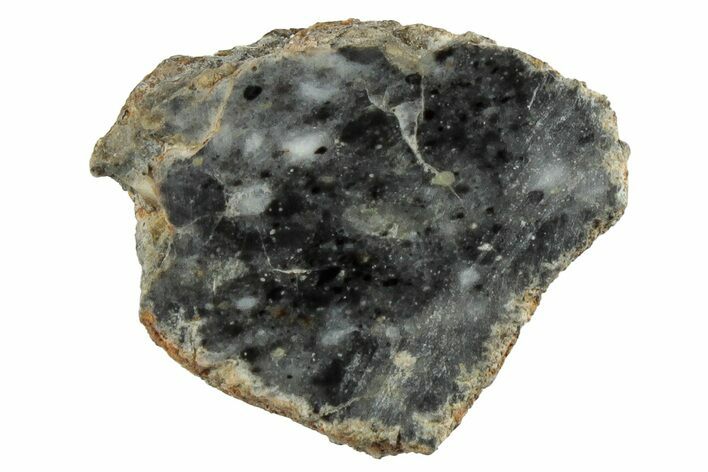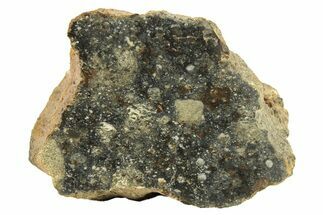This Specimen has been sold.
.63" Lunar Meteorite Section (1.54 g) - Bechar 010
This is a .63" wide (1.54 grams) lunar meteorite that is part of the Bechar 010 find in Algeria. It has been sliced and polished to a glossy finish on one side, displaying handsome gray clasts and some shock veins. It comes in an acrylic display case.
The Bechar Lunar Meteorites
The Bechar lunar meteorite is an assumed pairing of nine different finds discovered outside the city of Bechar on Algeria's northern coast in early 2022. Across the nine finds, as much as 17 kilograms have been officially recovered. All finds were recorded as numerous small stones lacking fusion crust. Exposed exteriors are light brown, and the partially buried portions of these fragments are coated in whitish orange substrate (caliche).
Bechars are all classic lunar feldspathic breccias, holding various white to dark gray clasts within. They mostly contain plagioclase, pyroxene, and olivine in a crystallized melt matrix. Some also show shock veins upon cutting and polishing.
The Bechar lunar meteorite is an assumed pairing of nine different finds discovered outside the city of Bechar on Algeria's northern coast in early 2022. Across the nine finds, as much as 17 kilograms have been officially recovered. All finds were recorded as numerous small stones lacking fusion crust. Exposed exteriors are light brown, and the partially buried portions of these fragments are coated in whitish orange substrate (caliche).
Bechars are all classic lunar feldspathic breccias, holding various white to dark gray clasts within. They mostly contain plagioclase, pyroxene, and olivine in a crystallized melt matrix. Some also show shock veins upon cutting and polishing.
Moon Rocks... On Earth...
Think the only moon rocks on Earth are samples brought back from Apollo missions? Think again!
Lunar meteorites are type of achondrite meteorites that were formed like other stony (chondrite) meteorites, but they were ejected into space by meteorites and other celestial bodies hitting the moon. Almost all lunar meteorites are brecciated amalgamations of feldspathic and basaltic rocks commonly found on the Moon's surface.
Lunar meteorites are pretty rare to find on Earth: the vast majority of meteorites are from the asteroid belt, and less than 1 percent of classified meteorites are lunar in origin. The total mass of all known lunar meteorites is probably less than 1,000 kilograms. Owning a piece of the moon is a pretty rare accomplishment!
One reason they are so rare is because lunar meteorites superficially look just like earth rocks. Even a true meteorite expert would not recognize a lunar meteor laying on the ground among earthly stones. Lunar meteorites have only been recognized in places naturally devoid of rocks, like sandy deserts and ice sheets. In fact, there has never been a lunar meteorite classified from North America, South America or Europe. Most are found in the Sahara Desert (Northwest Africa), Antarctica, or Oman. All Antarctic meteorites are governmental property so they cannot be privately attained.
Think the only moon rocks on Earth are samples brought back from Apollo missions? Think again!
Lunar meteorites are type of achondrite meteorites that were formed like other stony (chondrite) meteorites, but they were ejected into space by meteorites and other celestial bodies hitting the moon. Almost all lunar meteorites are brecciated amalgamations of feldspathic and basaltic rocks commonly found on the Moon's surface.
Lunar meteorites are pretty rare to find on Earth: the vast majority of meteorites are from the asteroid belt, and less than 1 percent of classified meteorites are lunar in origin. The total mass of all known lunar meteorites is probably less than 1,000 kilograms. Owning a piece of the moon is a pretty rare accomplishment!
One reason they are so rare is because lunar meteorites superficially look just like earth rocks. Even a true meteorite expert would not recognize a lunar meteor laying on the ground among earthly stones. Lunar meteorites have only been recognized in places naturally devoid of rocks, like sandy deserts and ice sheets. In fact, there has never been a lunar meteorite classified from North America, South America or Europe. Most are found in the Sahara Desert (Northwest Africa), Antarctica, or Oman. All Antarctic meteorites are governmental property so they cannot be privately attained.
TYPE
Lunar Breccia
AGE
LOCATION
Bechar, Algeria
SIZE
.63 x .54 x .26", Weight: 1.54 grams
CATEGORY
ITEM
#280812
 Reviews
Reviews












